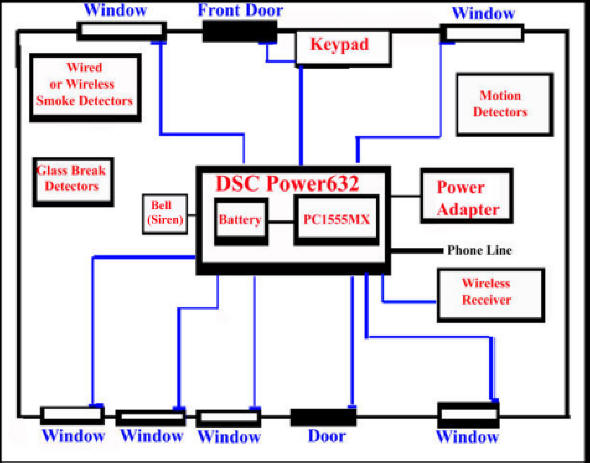
Shared Knowledge
"Security System - Digital Security Controls (DSC)
Overview"
3 November 2010
Summary: Digital Security Controls (DSC) manufactures a broad line of well-made home security system hardware that is sold under various names and installed by many different home security companies. DSC does not install security systems and does not sell directly to homeowners. An installed system is tailored to a specific home via system keypad programming of system main circuit board non-volatile memory. Most homeowners would find system programming to be difficult, if not impossible. DSC security systems can be program locked such that a homeowner can not change any security system descriptors without knowing a special "Installer Code". If you are buying a home with a DSC-based security system installed, include it on contract documents and make sure it works properly at home inspection walk-through.
Background:
Digital System Controls (DSC) is a Canadian company that designs and manufacturers home security system components.
DSC has been in business since 1979.
DSC makes a rather complete line of central controllers, keypads, wireless receivers as well as wired and wireless sensors.
DSC also makes several purpose modules that can be added to their systems, such as one that allows Internet control or use of a cell phone tower to contact a monitoring company or one to allow use of a key fob.
DSC is an original equipment manufacturer (OEM) that supplies their products to various security companies throughout the world.
DSC does not install security systems.
DSC does not sell directly to homeowners.
DSC hardware:
DSC hardware (main system board, smoke detectors, glass break detectors, motion detectors, keypads, etc.) all are well made.
As DSC hardware is used by so many different home security system companies and has been around for so long, that there is no shortage of components, either new or used.
An installed DSC-based security systems can be wired, wireless or a combination of the two. Newer homes tend to have wired sensors while older home have wireless-based installations.
DSC hardware components are relatively inexpensive.
Via expansion modules, additional hard wired zones can be added to a basic system.
Via the addition of a wireless receiver, wireless devices can be easily added to the system.
Various other add-on modules are available for DSC home security systems.
DSC systems that use wireless sensors require periodic battery changes. Some DSC devices use non-standard batteries that are not available everywhere.
DSC hardware components can be procured over the Internet from many sources to include eBay.
DSC home security systems include a battery backup to main house power. This battery allows for the system to sound alarms and call a remote monitoring station even if house power is lost. This battery has a life of about 5 - 7 years but is monitored by the system and the homeowner informed when the battery must be replaced.
DSC hardware is tailored to each specific home via main circuit board non-volatile (does not loose contents when power removed) memory programming. No special tools or devices are need to accomplish programming.
The main circuit board on a DSC system can be hardware reset to factory default settings as long as the system is not "locked."
Professional security companies tend to lock an installation when it is first installed such that a homeowner can not change characteristics of the security system and any subsequent modifications or adjustments to the system require the services of the system's security company installer.
DSC systems are designed to report system events to a monitoring station automatically over a telephone line. Monitoring services are provided by a security company for a monthly fee.
DSC security systems do not have to be remotely monitored but main circuit board programming must be changed to disable monitoring station communications.
A typical DSC security system installation.

Notes:
Each monitored window has a magnetic reed switch of the normally-open type. These type switches are used such that if someone tries to simply cut the line from the switch to the control panel, the control panel will sense an "open" and sound the alarm.
Each magnetic reed switch has 2 wires that must be run all the way back to the control panel.
Monitored windows and doors can be grouped into zones. By grouping, specific attributes can be assigned a group in Power632 programming. For example, a group can be defined that if an "open" is detected, sound the alarm immediately whereas another group can be defined to include a door and allow X number of seconds for a homeowner to disable the system via a keypad before sounding an alarm.
A DSC Power632 can have up to 6 active zones and via expansion modules as many as 32, not counting 32 wireless devices. A zone can consist of many windows and doors.
Door switches are usually of the normally-open plunger type embedded in the door frame. Doors close to keypads are normally connected to the keypad rather than running wires back to the control panel. This does require the keypad be assigned a specific zone in Power632 programming. A door contact is connected to the Z terminal of a keypad and to the black-wire terminal.
DSC makes both wired and wireless versions of smoke, glass break and motion detectors.
To use wireless devices, a wireless receiver must be installed and connected to the Power632. DSC makes several types of wireless receivers.
The Power632 is meant to communicate system events to a monitoring company via a phone line but does not have to be monitored.
A system may have one or more bells or sirens or may have none at all.
To add a DSC device to an existing installation, first confirm the new device is compatible with your installed system. DSC makes so many different devices and all are not compatible with each other.
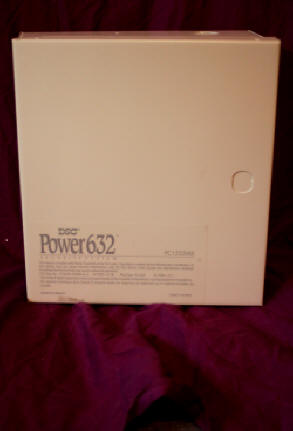
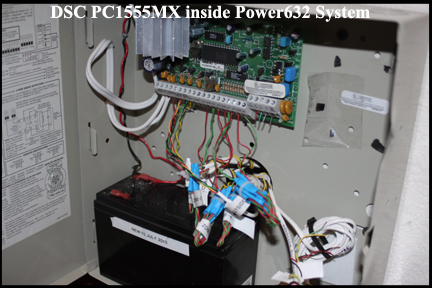
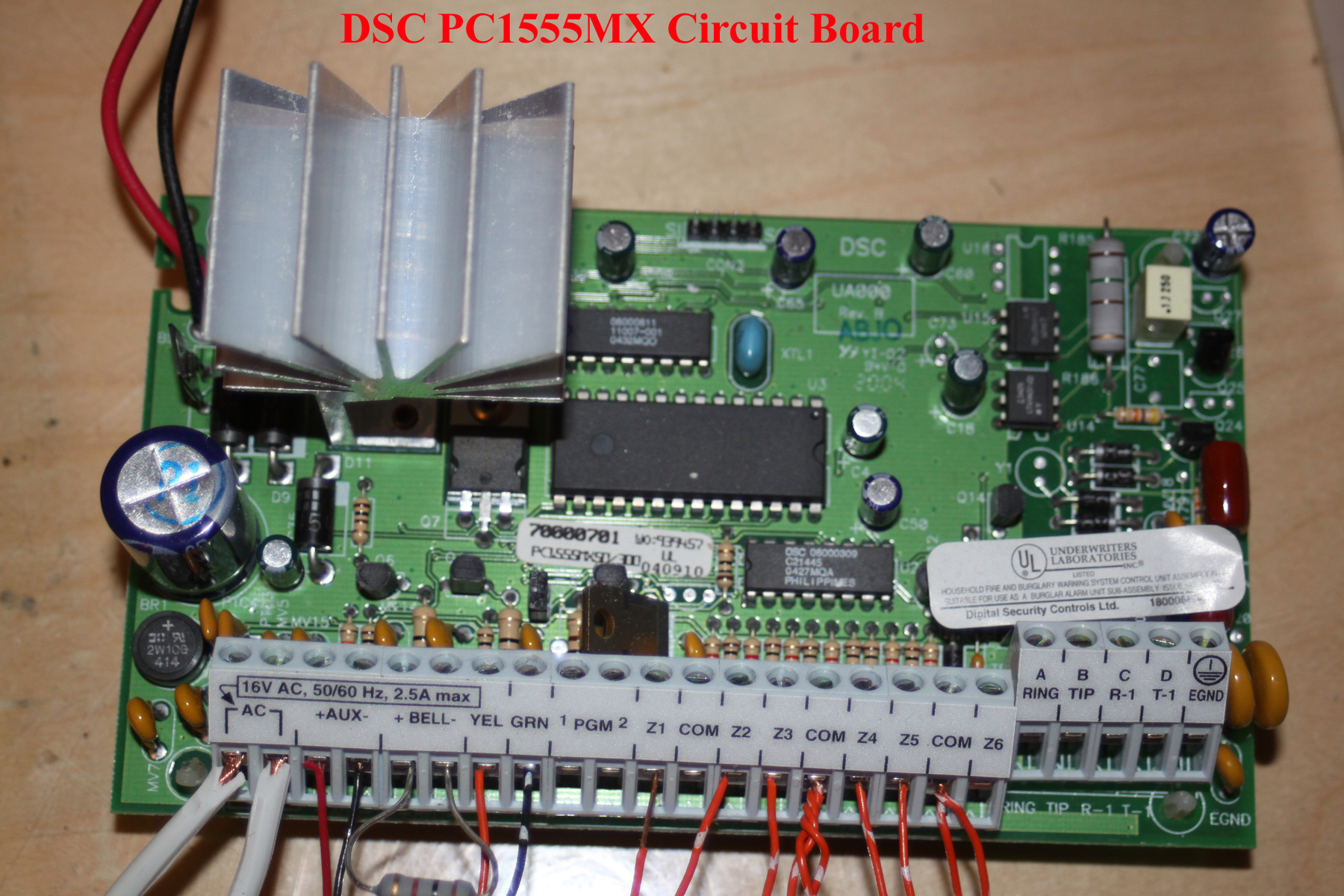
![]()
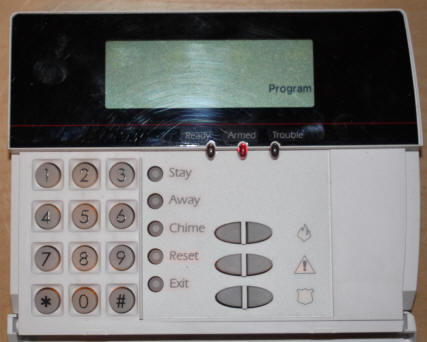
DSC programming:
DSC systems are tailored to a specific installation via programming of the main circuit board's non-volatile memory.
As DSC systems are only sold directly to security system companies, programming of the main circuit board, as defined in various DSC documentation, is a little obtuse and can be difficult for a homeowner or do-it-yourselfer (DIY) to figure out, but not impossible.
To program a DSC main circuit board, a DIY will need the installation manual of the specific DSC main circuit board installed.
To do any sort of programming of a DSC system, the Master and Installer Codes must be known. The defaults for these on a DSC PC1555MX system board are Master Code = 1234 and Installer Code = 5555.
At installation, the installer could have and probably did, change the Master and Installer Codes. The rationale behind changing these 2 codes is that the default codes are public knowledge and without changes, anyone with DSC knowledge could potentially enter a home and using default codes, disarm a system.
Without working Master and Installer Codes, there is nothing a homeowner can do to edit or change any settings of a DSC system.
For a DIY, if the main system board is locked, replacement is an option but make sure that replacement system board is not "locked" before procuring. Many DSC components are for sale on eBay. A replacement main circuit board means complete reprogramming.
DSC system remote monitoring:
The main system board of a DSC home security system includes a programmable telephone line autodialer. This means that the system, once properly programmed, is capable of calling a monitoring station and reporting a system event such as fire, intrusion, etc.
No special tools or devices are required to program the autodialer as programming is done via a system keypad.
As DSC hardware is so widely used, most monitoring companies should have the capability of changing autodialer programming such that you can reasonably expect to be able to switch monitoring companies as you see fit.
Although DSC home security systems include an autodialer, the system does not have to be monitored. However, you can not simply disconnect the phone line attached to the main circuit board of a DSC home security system as this will be diagnosed by the system as telephone line fault and depending on system programming, not allow a home owner to arm his or her system until the fault has been corrected.